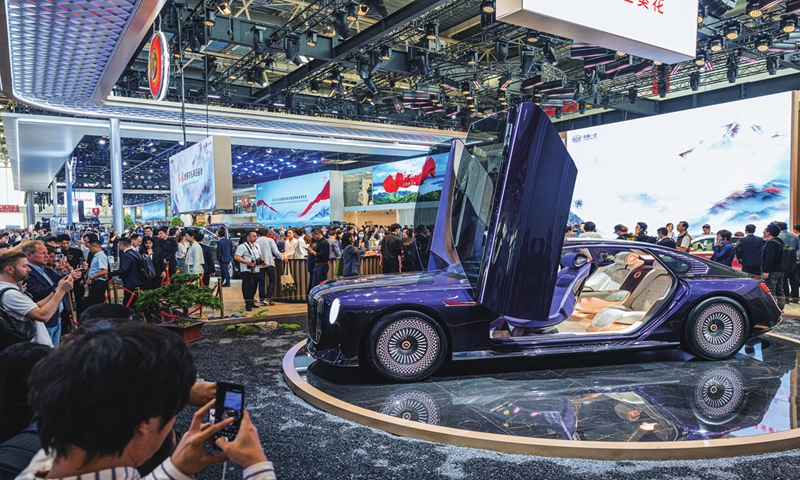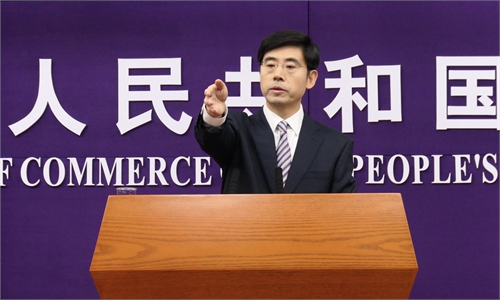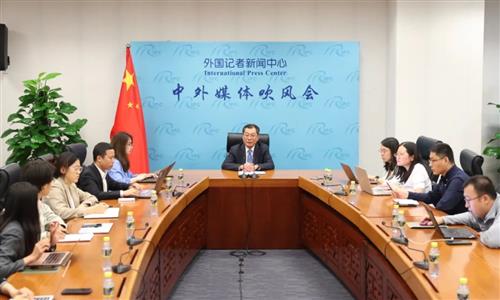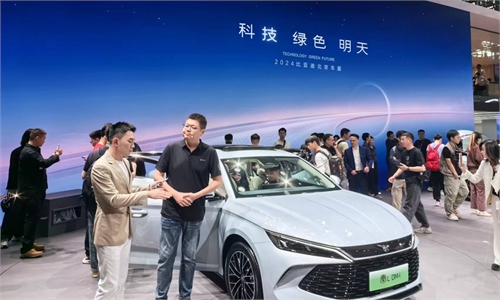
Visitors take photos of the Hongqi Golden Sunflower Premium model at the 2024 Beijing International Automotive Exhibition on April 25, 2024. Photo: Li Hao/GT
After a nearly-four-year hiatus, the 2024 (18th) Beijing International Automotive Exhibition (Beijing Auto Show) kicked off on Thursday. The event features more than 1,500 exhibiting companies, 278 new-energy models, 117 world premiere models, and 163 press conferences, demonstrating the new development trends of China's domestic and global automotive industry. It also showed to the world in the most vivid manner why China's new-energy vehicle industry leads the way and what it means to the world.
Visitors had to queue for more than 40 minutes before moving to the main entrance of the exhibition hall. Many people lined up to buy food at the exhibition restaurant. The exhibition halls of some car companies were too crowded to enter. The "internet celebrity" chiefs of major car companies personally went to the exhibition to compete for popularity and marketing... These are all concrete manifestations of the popularity of this year's Beijing Auto Show. At this auto show in particular, China's domestic brands have become the mainstay, and new-energy vehicles have taken center stage. People are full of expectations for what new models and technologies Chinese automakers will launch.
Many people noticed that there were obviously more foreigners at this auto show, and the attitude of foreign car manufacturers has also changed significantly. BMW, Mercedes-Benz, and Audi all brought luxury exhibitor lineups and models. Executives from multinational car companies not only came to promote their own products, but also carefully studied the technology and design of Chinese new-energy vehicles. A considerable number of overseas dealers, suppliers, media and even car owners came to the exhibition. A video of South Koreans observing Chinese new-energy vehicles went viral on the internet. Chinese society has a very open attitude toward this. Openness has always been the motto of the Beijing Auto Show.
In the era of traditional fuel vehicles, China's automobile industry generally played the role of catcher, but it has never abandoned its efforts to develop independent brands and innovations. Relying on the technological accumulation gained through years of exploration and relying on China's huge modern production capacity advantages, engineer dividends and domestic market, Chinese car companies have gained a head start in the historic opportunity of automobile transformation from fuel to new energy. In 2023, China's automobile exports surpassed Japan for the first time and ranked first in the world. In the first quarter of 2024, China exported 1.3 million vehicles, a year-on-year increase of 33.2 percent, continuing this momentum.
The global automobile industry pattern had not undergone major changes for many years, and the fundamental driving force for this change is the technological revolution. This is a normal thing, but it has tested the overly sensitive nerves of some people in the West. However, there has been none of the "overcapacity," "weakened demand" and "leaving China" that they expected for the Beijing Auto Show, nor "Chinese car companies squeezing foreign car companies." What people can see is people learning from each other's strengths to achieve win-win cooperation. They are hyping up "overcapacity" of new-energy vehicles in China, and creating a narrative attached with values and hegemonism in an attempt to curb and set limits on China's industrial development. Their fundamental purpose is to use trade protection policies and public opinion offensives to disrupt the momentum of China's new-energy vehicle industry.
Why is the Beijing Auto Show so popular? Because of the global market demand, especially the high interest and enthusiasm for technological breakthroughs in new-energy vehicles. According to calculations by the International Energy Agency, in order to achieve the goal of carbon neutrality, global sales of new-energy vehicles need to reach approximately 45 million units by 2030, 4.5 times that of 2022. It shows that global demand is real and there is no such thing as "overcapacity" at all. The green energy revolution may stimulate a round of industry reshuffles, and market competition is cruel, but it is by no means the kind of life-and-death competition that some people in the West have in their minds.
Chinese companies are not afraid of competition, but competition must be fair and just. Chinese new-energy vehicle companies play the role of industrial collaborators and healthy competitors, which not only benefits consumers, but also benefits the vast number of developing countries, thereby making up for the insufficient and unbalanced global development of high-quality green production capacity, and at the same time encouraging more traditional car companies to invest more energy and resources into green transformation. In this regard, the right approach for the world is to work together to take advantage of the opportunities brought by the development of green industries.



